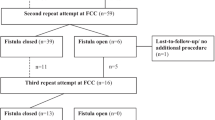Abstract
Introduction and hypothesis
Obstetric fistulas are injuries to the genital tract in women without emergency obstetric services. Parity may predict the characteristics of fistulas that affect closure success and residual incontinence. Circumferential fistulas may predispose patients to postoperative incontinence. We hypothesized that primiparous women have more distal fistulas than multiparous women, leading to more scarring and circumferential fistulas.
Methods
A retrospective observational study was conducted on 1,856 women with obstetric fistula evaluated at three sites by three providers. Fistulas were classified using the Goh classification system. Women aged 10 to 55 years were classified as primiparas or multiparas. Analysis by parity of fistula type and size, degree of scarring, and presence of circumferential defect used the Chi squared or Fisher’s exact test, and binary logistic regression.
Results
Of the 1,841 (99.2 %) women included, 878 (47.7 %) were primiparas and 963 (52.3 %) were multiparas. Primiparas were more likely to have distal fistulas, type 4 being most common (31.5 %), whereas multiparas were more likely to have proximal fistulas, most commonly type 1 (48.1 %). Primiparas were more likely to have moderate to severe scarring (11.7 % vs 5.6 %; p < 0.001), and category III (57.1 % vs 39.2 %; p < 0.001), but not to develop circumferential fistulas (5.6 % vs 4.0 %; p = 0.127), be present for repeat surgery (7.1 % vs 7.6 %; p = 0.721), or have ureteric involvement (1.5 % vs 2.2 %; p = 0.301). Multivariate analyses confirmed increased risk with primiparity for distal fistula and scarring.
Conclusions
As hypothesized, primiparas were more likely to have distal fistulas and more scarring, but were not more likely to have circumferential fistulas. Surgeons should plan accordingly.
Similar content being viewed by others
References
UNFPA campaign to end fistula http://www.endfistula.org.
Goh JT. Genital tract fistula repair on 116 women. Aust N Z J Obstet Gynaecol. 1998;38(2):158–61.
Muleta M, Rasmussen S, Kiserud T. Obstetric fistula in 14,928 Ethiopian women. Acta Obstet Gynecol Scand. 2010;89(7):945–51. doi:10.3109/00016341003801698.
Browning A. Short communication: the circumferential obstetric fistula: characteristics, management and outcomes. BJOG. 2007;114(9):1172–6. doi:10.1111/j.1471-0528.2007.01329.x.
Goh JT, Browning A, Berhan B, Chang A. Predicting the risk of failure of closure of obstetric fistula and residual urinary incontinence using a classification system. Int Urogynecol J Pelvic Floor Dysfunct. 2008;19(12):1659–62. doi:10.1007/s00192-008-0693-9.
Frajzyngier V, Ruminjo J, Barone MA. Factors influencing urinary fistula repair outcomes in developing countries: a systematic review. Am J Obstet Gynecol. 2012;207(4):248–58. doi:10.1016/j.ajog.2012.02.006.
Barone MA, Frajzyngier V, Ruminjo J, Asiimwe F, Barry TH, Bello A, et al. Determinants of postoperative outcomes of female genital fistula repair surgery. Obstet Gynecol. 2012;120(3):524–31. doi:10.1097/AOG.0b013e31826579e8.
Goh JTW, Krause HG, Browning A, Chang A. Classification of female genito-urinary tract fistula: inter- and intra-observer correlations. J Obstet Gynaecol Res. 2009;35(1):160–3. doi:10.1111/j.1447-0756.2008.00831.x.
Browning A. Risk factors for developing residual urinary incontinence after obstetric fistula repair. BJOG. 2006;113(4):482–5. doi:10.1111/j.1471-0528.2006.00875.x.
Author information
Authors and Affiliations
Corresponding author
Ethics declarations
Conflicts of interest
None.
Rights and permissions
About this article
Cite this article
Lorencz, E., Galvin, S.L., Browning, A. et al. Parity as a predictor of obstetric fistula classification. Int Urogynecol J 28, 941–945 (2017). https://doi.org/10.1007/s00192-016-3197-z
Received:
Accepted:
Published:
Issue Date:
DOI: https://doi.org/10.1007/s00192-016-3197-z




